New plans are set to be announced for Piccadilly: shame we didn't get part of the Eiffel Tower
In a few weeks there will be a public consultation about the future of Piccadilly Gardens. This will be based on a winning design from a shortlist comprising Planit-IE, LDA Design, Studio Egret West and West 8. The budget is £25m.
The design will hang around for at least a generation so it's critical this time the square (it's not a gardens) is decluttered and made an asset for Manchester rather than something locals, tourists and alien visitors from beyond the Orion Nebula whine on about. That atrocious decking area blocking half the space needs to disappear as soon as possible as discussed in our 2022 article.
One design would have left the city with one of the most curious structures ever built in these islands
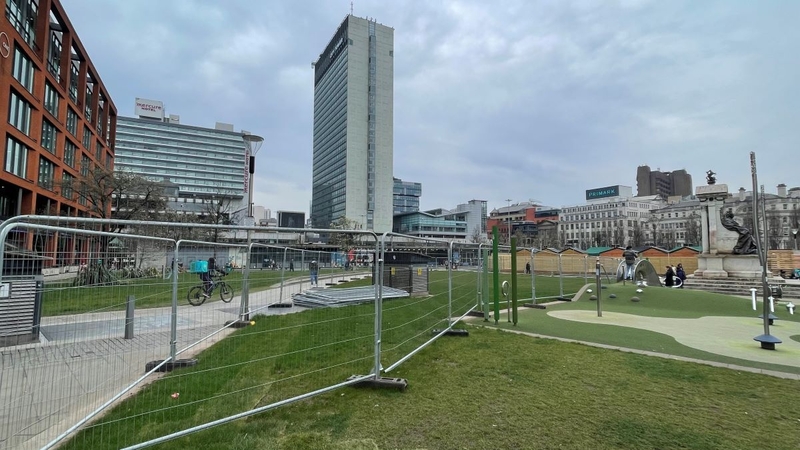

So the wheel turns. Piccadilly Gardens is the most over-imagined place in Manchester. Idea after idea has come and gone, especially since Manchester Royal Infirmary moved south to its present Oxford Road location.
It has always been a place of controversy. This is from Hobson’s Choice by Harold Brighouse in 1917. ‘In Manchester, at the present day, the finest city site is derelict, an eyesore and a byword. Some years ago the town infirmary was there but the building had become too small and a huge new place was built, leaving the most central site in all the city to become the King Charles’s Head of Council debates, some wanting an open space, others a municipal Cotton Exchange, others an Art Gallery. Meanwhile the grass grows in Piccadilly and periodic visitors are left to wonder where the Manchester man’s reputation for business comes in.’
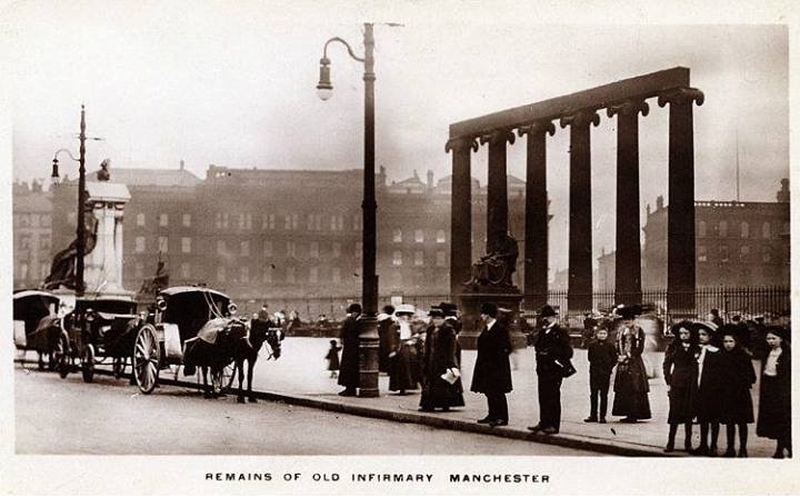
The last re-envisioning before the 2002 Commonwealth Games left the city with the present cluttered mess, with idiotic raised planting that isolates the nineteenth century statues, the clumsiest fountain imaginable, a massive concrete wall presenting its backside to trams and buses and a ludicrously drab office building stealing space on the south side.
The various dreams presented below were all better than what we have presently. Let's hope that the next incarnation meets with both approval and, over time, affection. Indeed let's hope the 'Gardens' become a proper square, as we discussed in our article here.
Anyway, here are some grand ideas for Piccadilly Gardens that were never realised. Some of them are very entertaining.
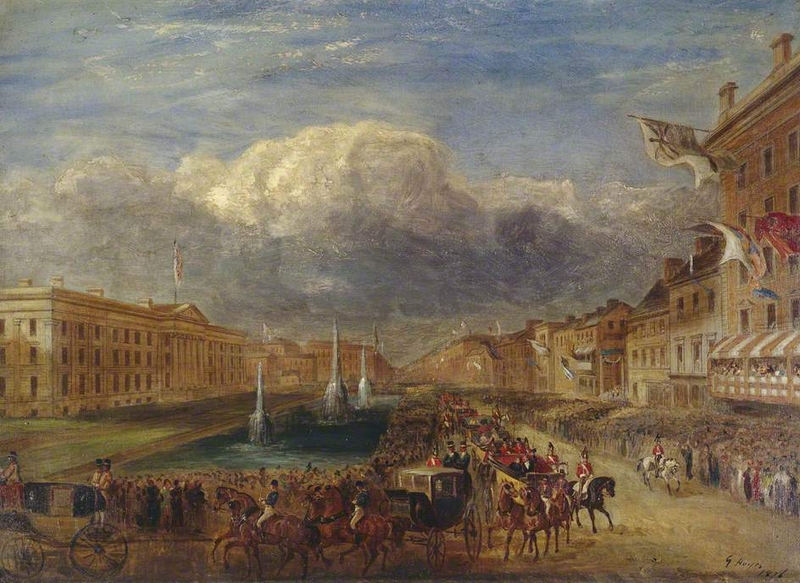
Art for art sake
Between the World Wars, Piccadilly was chosen as a location for a new City Art Gallery. The criteria of a design competition specified ‘that no more than one eighth of the Piccadilly Gardens site should be taken up by the new building. The cost of the building must not exceed £300,000 and the building should be faced with Portland stone and be approached by a fine flight of steps. Its character must be monumental and its construction fireproof, a prominent clock might be provided but elaborate decoration detail is not desired and the effects of the building would depend, externally and internally, mainly on the proportions and massing used. A part of the building, preferably quietly situated off the mainstream of traffic, must be set aside for a Hall of Memory to commemorate Manchester men of all ranks and services who fell in (World War I). This should be beautiful and impressive.’
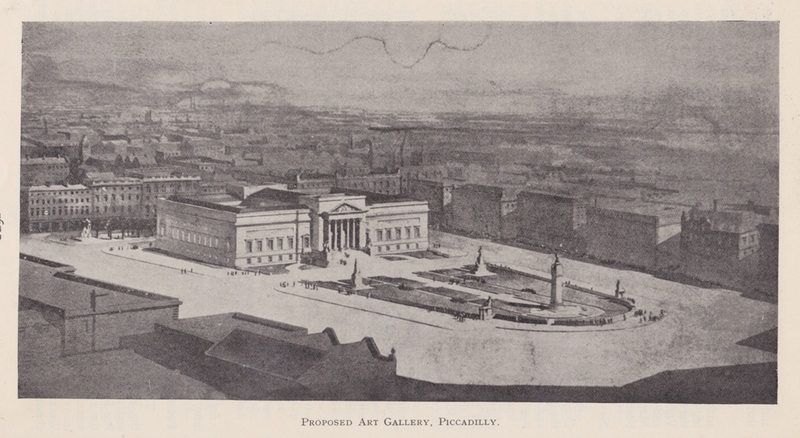
Shown here is the powerful proposal of revival Classicism from Ernest Berry Webber, whose major work is Southampton Civic Centre from 1932, which also included an art gallery.
The design was strong, very formal and very masculine. Yet while bigger than Manchester’s present art gallery on Mosley Street, it is by no means better, indeed looks similar and is much clumsier. Manchester probably did the right thing in keeping faith with Charles Barry’s 1820s design.
The best of the art gallery scheme would have been the creation of a properly scaled central open space which Manchester has always lacked. A large formal garden area with much hard paving and a sweet reflection pool down the centre would have stretched west, with the art gallery placed at the east of the site where the hapless One Piccadilly building presents sulks. Statues would have been re-jigged and a clock tower built as an eye-catcher and a balance to the art gallery at the other end of the open area.
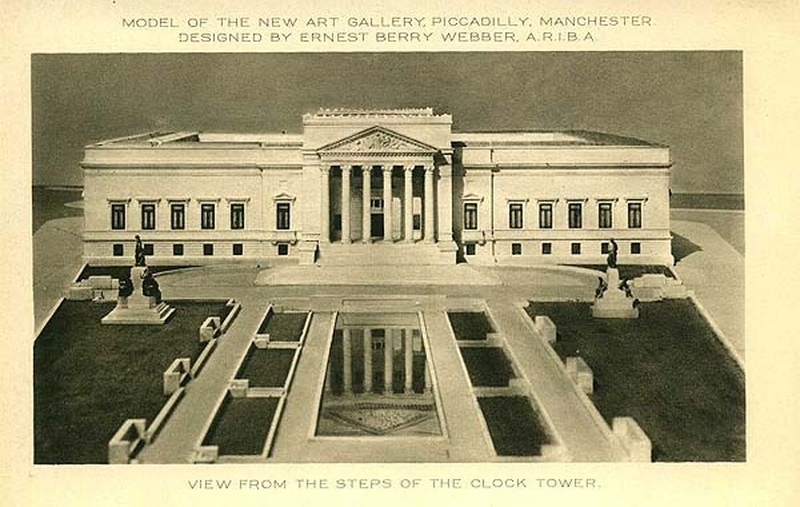
Regent Street in the North
A supremely elegant early-nineteenth century proposal for Piccadilly never came close to getting off the ground. The city was changing far too quickly, yet the ideas here might have turned Piccadilly into the equivalent of the John Nash designed Regent’s Park and Regent Street area of London. Look at the crescent on the picture on these pages, how it widens the public area of Piccadilly. There are elegant rotundas and domes, pilasters, and heavy cornices with powerful swags. There’s huge statuary and long pond. This is the most stylish solution ever proposed for Piccadilly focused on Manchester Royal Infirmary and was probably designed by Thomas Witlam Atkinson. The latter was an interesting character and after trying to make a living as architect and failing became a famous explorer and an infamous bigamist.
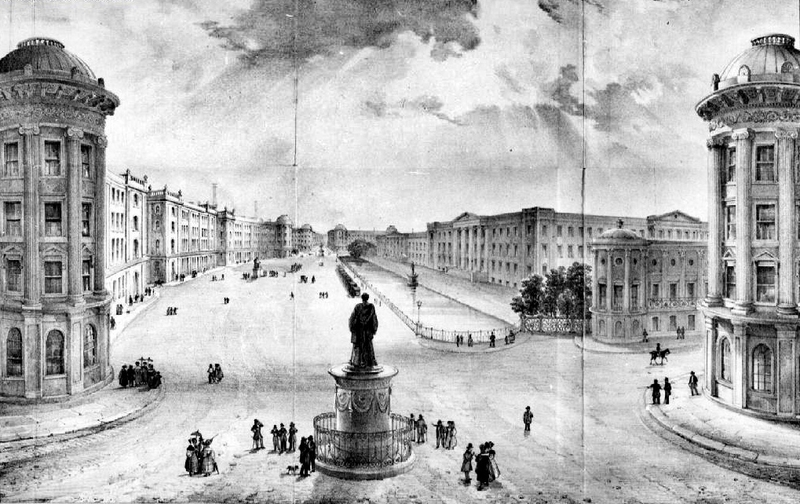
Of course Manchester did gain a John Nash Crescent in Hulme in the 1960s (click here) and it was a shocker. The problem for Atkinson's design for Piccadilly was that the middle-class and the wealthy were already starting to abandon the city core surrounded as it was by smoke-blasting factories and, of course, the unsightly poor. As Charles Rowley of Ancoats would thunder later in the century, worried that those who made their money from Manchester were deserting it in the evenings and therefore not engaging with civic life: “If God made the country and Man made the town, the Devil made the suburbs”. His anger came too late. The rich householders had already mostly fled the centre. They wouldn’t be back until the arrival of the third millennium.
The huge cathedral that never got built
Old British cities such as York and Chester, Salisbury and Winchester are defined by Cathedrals. It’s the same on the Continent in Chartres, Santiago de Compostela, Cologne. Even capital cities often evoke as a first image the cathedral, St Paul’s, St Peter’s, Notre Dame.
Not cities such as Manchester. Nor for that matter Birmingham, Leeds, Newcastle. Only Liverpool of the industrial North and Midlands in the UK can lay claim to Cathedral fame and that’s down to the unwelcome sectarian tensions between C of E and RC that led to the creation of two large cathedrals.
Thus it was a surprise to discover plans for a major new cathedral where the hapless Piccadilly Gardens lurk. Clearly some people in Manchester wanted the city to be as famous for its Cathedral as it was for its Free Trade Movement and for its Cotton Exchange.
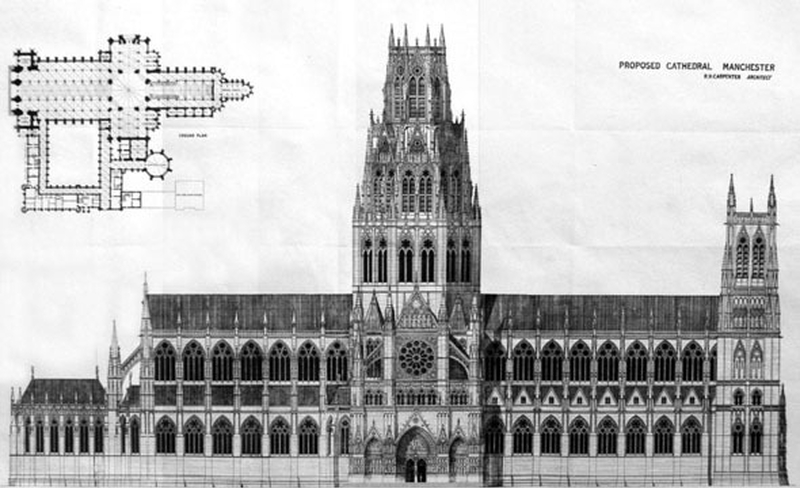
In fact the plans here reveal a determined idea to move away from filthy lucre and trade and introduce a more spiritual Manchester. The fact it was never built shows Mancs were less susceptible (or even more sensible) although it meant the city missed out on an epic.
This cathedral would have been vast. Its main tower would have been close to 350ft, higher than the Town Hall tower, as high as the nearby City Tower from 1962 (350ft to the roof level excluding the communication mast), and easily the highest cathedral tower, if not spire, in the UK. The west front entrance bears some resemblance with its three pointed arches to Salisbury Cathedral, the whole arrangement to Rouen Cathedral. Or maybe York Minster but bigger. Ambitions ripples through the plan.
Indeed the tower is so wide at its base, an epic octagon like at Ely Cathedral, it could have almost contained the present area of Manchester Cathedral. The nave length of ten bays would have rivalled the length of Europe’s largest medieval cathedral Winchester.

The architect of the proposed Cathedral was Richard Herbert Carpenter. This would have been his masterwork, it would have dominated Piccadilly were by this time the site was proving too constrained for the existing hospital. Carpenter was seriously talented too, as evidenced by his Lancing College Chapel in Sussex.
For reasons unknown the project was never carried forward. Perhaps the cost of such a huge building was the problem, perhaps the present Cathedral was deemed sufficient. It may have been thought there was simply no need to rip the 1000 year centre of Manchester Anglican worship from its roots, away from traditional centre of Christian worship in the city. After all the building they already possessed was full of beauty, if of a quieter more contemplative nature, than the Piccadilly project might have displayed.
The best plan ever for Piccadilly Gardens
You've got to love this one. It’s a cracking idea and would have been Manchester’s steam punk building par excellence, like something from Philip Pullman’s Dark Materials made real, or a set piece location for the Sherlock Holmes movies with Robert Downey Jnr and Jude Law directed by Guy Ritchie.
The idea was mooted as an extension to Manchester Royal Infirmary which had been housed in Piccadilly Gardens for more than a century. Unfortunately by the close of the 1800s it was too small, so there were a couple of solutions put forward.
Either a fresh site could be sought and bought to host the ever expanding hospital complex or a very imaginative solution in Piccadilly could be conjured up.
The idea illustrated on this page is pure magic. If space is an issue build upwards. But where to look for inspiration? Why of course, Paris, with its Eiffel Tower from 1889, or maybe even Blackpool with its just completed tower. Given how the designs on this page show a very French-style mansion crowning the proposal we have to favour Paris as the model.
So the idea was to build the lowest stage of the Eiffel Tower over the existing building with another hospital building placed on top of this, vertically above the older hospital. A lift and presumably stairs would connect the two buildings. The total height appears to be something over 250ft.
It’s a mad notion but it’s a shame it was never built. This would now be an incredible tourist draw. The hospital would have had to move in the end even with this solution so no doubt the city would now possess one of the most curious structures ever built in these islands. Maybe the place would be a hotel, or maybe the art gallery described earlier in this article might have moved in. Either way to promenade around the structure on that elevated platform would have been both thrilling and somehow ridiculous.
The images and much of the article comes from Jonathan Schofield's books Lost & Imagined Manchester and Illusion & Change Manchester. You can buy the books here which contains detailed descriptions of the Piccadilly Cathedral and Art Gallery proposals.
The article above has been updated from the one that appeared five years ago. The Infirmary tower image at the top of the page was created by Ste Allan after reading this piece.
If you liked this then you'll probably like:
Piccadilly Garden decked to death
The Northern Quarter Park
This city: City centre wasteland finally, at last, to become active
Get the latest news to your inbox
Get the latest food & drink news and exclusive offers by email by signing up to our mailing list. This is one of the ways that Confidentials remains free to our readers and by signing up you help support our high quality, impartial and knowledgable writers. Thank you!









